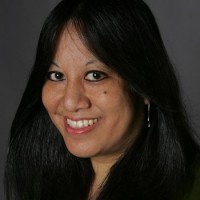“AFRICANS SHOULD BE CONSIDERED A DIFFERENT SPECIES,” declared a writer on the message board.
“All of the races descend from a single COMMON TO ALL population some 50,000 ago (Europeans, Asians, Australians, Americans). All except Africans …,” the writer continued, dropping words while using the language of science to make a point.
“Those are different species.”
For Aaron Panofsky and Kushan Dasgupta, posts like this on Stormfront, the White nationalist Internet forum, and on other online neo-Nazi message boards hold the key to understanding how and why White supremacist groups appropriate scientific research — in particular about genetics and biology — to advance their ideas, viewpoints and agendas of hate.
Panofsky, a UCLA professor of public policy and director of the Institute for Society and Genetics, and Dasgupta, a postdoctoral fellow at the institute, have spent countless hours scrutinizing White nationalist discussion boards, as well as blogs and online magazines, first as part of a National Institutes of Health study, and now as part of UCLA’s new Initiative to Study Hate.
“One of the things we wanted to study was how the emotive, emotional discourse of hate was being used by these people who are doing ‘science talk,’” Panofsky said. “When is science being connected to hate and when is it not? When is science connected to more emotional aspects of hateful nationalist discourse?”
Often the science discussion revolves around how genetics “proves” that Blacks and Whites are fundamentally different from each other, he said. “They’re not just saying, ‘We don’t like these people,’ or ‘The Bible says.’ They’re very frequently trying to mobilize science talk to say White people are burdened by Black people and Latinos in society.”
At the heart of the study is how science is used as a tool to dehumanize or delegitimize members of another group. “There might be a string of logic where the science is used to ‘prove’ that some group should be treated as less than human. That then justifies emotional, hateful responses,” Panofsky said. “That unleashes hate on that lessened, dehumanized, subhuman group.”
For example, White nationalists have argued that science “proved that people of African ancestry were not adapted to being civilized, that interracial relationships would lead to unfit offspring, and that’s why we have to have anti-miscegenation rules and why we need to keep them suppressed and contained,” he said. “That’s one of the historic pathways by which science dehumanized and then led to hate. What we want to know is: Is that pattern still holding?”
Misogyny, racism — and decorum
Central to Panofsky and Dasgupta’s research is Stormfront, the oldest and largest White nationalist Internet forum, with nearly 375,000 registered members and more than 14 million posts. The site was founded in the 1990s by Don Black, a former Ku Klux Klan leader and self-proclaimed “racialist.” The Southern Poverty Law Center, a civil rights law firm in Montgomery, Ala., has called Stormfront “a magnet and breeding ground for the deadly and the deranged” and labeled it the “murder capital of the Internet.”
While there are numerous pro-White chat groups and online message boards, magazines and blogs, Panofsky and Dasgupta opted to focus on public-facing sites that are open to anyone. Stormfront has a “deep historical archive,” Panofsky said, “and it’s all available. It’s threaded discussions, and these discussions sometimes go on for years.”
Not all Stormfront posts deal with race — or hate. There are sections identified as Poetry and Creative Writing, Health and Fitness, Music and Entertainment, and Dating Advice, as well as a forum labeled Science and Technology. Discussions linked to science and hate can spring up almost anywhere on the site.
Because of the way Stormfront is set up, the researchers are unable to use data-mining techniques to scrape the site for relevant posts. That means tracking conversations must be done manually, as the researchers cast a wide net to uncover ways in which aspects of science pervade everyday conversations.
“Sometimes they have science and technology conversations that are literally about clean energy and stuff like that,” Dasgupta said. “I’m not sure why they’re having it with one another on this type of message board rather than somewhere else, but we are trying to study when, from the everyday vantage point of a White nationalist, science becomes salient to their thinking, and when it is not salient to their thinking.”
Panofsky and Dasgupta are studying interchanges in Stormfront’s science and technology forum, but they’ve started looking at other forums that are not science-specific to see how such assumptions make their way into regular conversation. Participants on Stormfront engage in “rational” debates — “rational in the sense that it’s rational from their perspective,” Dasgupta said — on any number of topics, including science-laced discussions about the role of women in White nationalism.
“This is where a lot of misogyny comes into play,” he said. “At what point is their belief about women something that’s just based on tradition, religion and those types of things, or are they starting to ground their ideas about the role of women in scientific thinking — biological stuff like hormones, or evolutionary theories. Things like, ‘They are just not as smart in IQ testing.’”
Stormfront’s guidelines warn against advocating or suggesting any activity that is illegal under U.S. law and urge members to “keep discussions civil and productive.” That includes, for example, not using profanity and racial epithets. “Make an effort to use proper spelling, grammar, punctuation, and capitalization (no ALL-CAPS posts).”
For White nationalists, these simple rules of decorum are important.
“Part of what we’re discovering is that these people are so invested in science because they’re afraid of being irrational,” Dagupta said. “Fear of irrationality is a big part of their belief system. As emboldened as some of these extremists might present themselves, their fear of being seen as not rational is on some level really paralyzing to them.”
“They want to get away from that label, ‘You’re just a crazy racist,’” Panofsky added.
“Right,” Dasgupta said. “As long as they’re a justified racist, that’s much more meaningful to them.”
UCLA and the study of hate
The Panofsky and Dasgupta project is one of 23 selected for UCLA’s Initiative to Study Hate, a three-year pilot program led by David Myers, a distinguished professor of history and director of the Luskin Center for History and Policy.
“What a world that they’ve uncovered: the deployment of scientific idiom to garb or cloak these racist sensibilities,” Myers said of Panofsky and Dasgupta.
The Initiative to Study Hate, launched in late 2022 with a $3 million contribution from an anonymous donor, brings together UCLA researchers from all corners of the campus whose diverse projects share a common goal: exploring the genesis of hate and, ultimately, looking for ways to combat it.
The projects tackle wide-ranging subjects that include the effects of bullying and the criminal justice system on LGBTQ+ youth; the dehumanization of people experiencing homelessness; the link between biases against undocumented immigrants and depor- tation or legalization status; and racist hate speech in high schools.
Research teams meet monthly — a grant requirement — to share insights, ideas and feedback. “We’re trying to create a community of scholars that works together,” Myers said. “While encouraging autonomy and individual discretion, we really want to marshal the powers of these individual teams and create something grander than the work of any single one of them. This is an experiment of bringing together researchers out of the silos to which we are conditioned and dwell in.”
Understanding to challenge
Other studies have investigated the role of science in society. The Panofsky and Dasgupta project is unique because it focuses on efforts that involve the use of science to validate messages of hate. The researchers are focused on how these groups use science in conjunction with other aspects of their belief system.
“This is a movement in which science is very central to their belief system, going back to the history of World War II and Nazi eugenics. … There’s often an emphasis on science,” Dasgupta said. “While it’s central to their outlook on the world, it’s not necessarily always the first thing someone will mention in an argument, but it might be something that eventually gets folded into the argument.”
Although their research is still in its early stages, Panofsky and Dasgupta see practical applications for their findings. Understanding how hate groups use science to further their agendas will help dismantle their arguments.
“It’s easier to challenge these ideas, or at least talk about them in a much more intelligible and even responsible way, if we just know the variety of ways in which hate is articulated, rather than assuming that hate has just one clear, discernable meaning,” Dasgupta said. “One of the big outcomes of this project is, hopefully, that it gives people a much more multifaceted understanding of extremism.”
Sometimes, White nationalist communities mask their hatred in denials, rejecting the idea that they are spewing hate. “They’ll say, ‘We don’t hate people,’ ‘We’re not hateful; we just want nothing to do with those people,’” Dasgupta said. “Other times they’ll say things like, ‘We’re not hateful, it’s the rest of the world that is trying to get us to hate our White identity.’”
Wrapped in these denials are often distortions or misinterpretations of scientific research to fit the argument of the hate they are advancing. White nationalists might, for example, falsify numbers, or use partial statistics to make a point while claiming that academics are “getting it wrong.”
“Sometimes it is out-and-out falsification. Sometimes it’s strategic amplification of a story. Sometimes it’s decontextualization, removing the exculpatory information,” Panofsky said. “And sometimes it’s more subtle misdescriptions and then an argument on top of that, like, ‘Oh, when those UCLA scientists tell you correlation does not equal causation, they’re just saying that to confuse the real, direct story that you can see right here on the page if you just look.’”
The concern, Panofsky said, is how curious young people might read message boards and be swayed into thinking the arguments are legitimate.
“One of the things we have been watching with dismay is the way that these White nationalist groups package scientific misinformation for consumption and distribution,” he said. “If we’re going to either debunk or challenge this, it probably won’t be [by] targeting the people themselves, but it will be [by] pricking the imprimatur of sophistication or of legitimacy in the aims of those folks.”
Panofsky and Dasgupta are trying to tease out and re-theorize what constitutes “hate.” Much of the content they have seen is focused on demonization, either of Afro-descended peoples or women.
“That’s one way of thinking about how they’re hateful. But some of these are also re-narrated or commented upon [by] others in a factual tone of voice, which doesn’t have the emotive quality that we associate with hate,” Dasgupta said. “Does that mean they’re not hateful? We don’t have an answer to this yet, because this is what we’re trying to figure out how to answer.
“But it helps convey how the study of hate is considerably more challenging than we might think at first glance.”

























